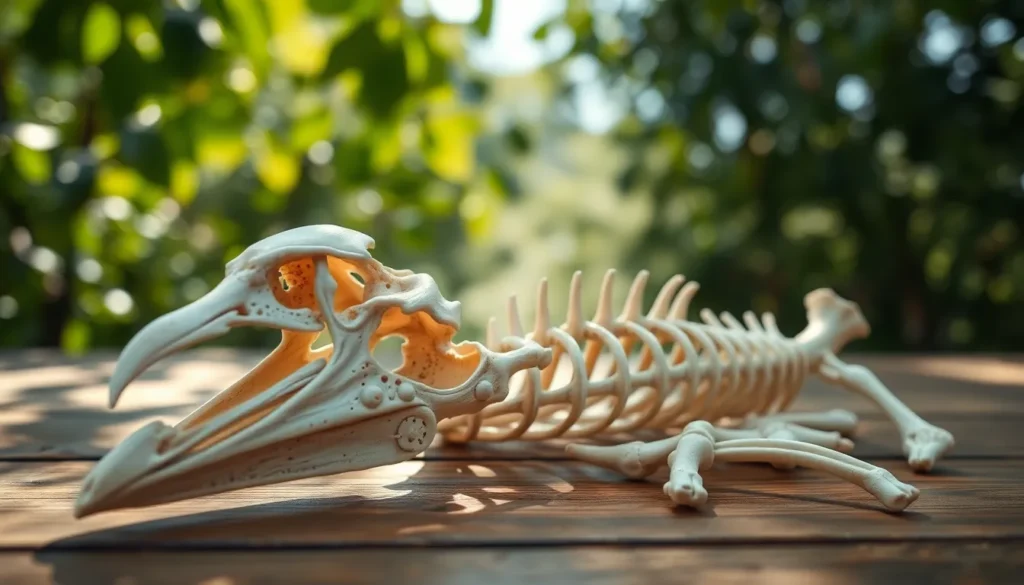Bird bones represent one of nature’s most incredible engineering marvels. We’ve all marveled at birds soaring effortlessly through the sky, but the secret to their flight lies in their remarkable skeletal structure. These hollow, lightweight bones don’t just enable flight—they’re packed with fascinating adaptations that have evolved over millions of years.
What makes bird bones so special? Unlike our solid mammalian bones, avian bones are hollow with internal struts that provide maximum strength while minimizing weight. This pneumatic bone system is so efficient that it’s inspired modern aerospace engineering and architectural designs.
We’re about to explore the incredible industry of bird bones and discover how these delicate yet powerful structures work. From their unique internal architecture to their role in breathing and flight, you’ll gain a deeper appreciation for the remarkable creatures that share our skies. Let’s jump into the fascinating science behind one of evolution’s greatest success stories.
What Makes Bird Bones Unique
Bird bones exhibit remarkable structural adaptations that distinguish them from all other vertebrates. These specialized skeletal features enable birds to achieve powered flight while maintaining the strength needed for survival.
Hollow Structure and Air Sacs
Pneumatic bones contain internal air spaces that connect directly to the respiratory system through specialized air sacs. Major bones including the humerus, sternum, and vertebrae feature these hollow chambers that reduce overall skeletal weight by up to 20% compared to solid bone structures. Air sacs extend into the bone cavities through small openings called pneumatic foramina, creating an integrated system that serves dual purposes of weight reduction and respiratory efficiency.
Large flight birds like eagles and hawks possess the most extensive pneumatization, with air spaces penetrating deep into their wing bones and skull. Smaller songbirds show less pneumatization but still maintain hollow structures in key flight bones. This air filled architecture allows birds to maintain structural integrity while achieving the lightness essential for aerial locomotion.
Lightweight Yet Strong Design
Trabecular bone architecture in birds creates internal scaffolding that maximizes strength while minimizing mass. Thin outer bone walls surround intricate internal struts arranged in geometric patterns that distribute mechanical stress efficiently throughout the structure. This design produces bones that weigh 40-50% less than equivalent mammalian bones while maintaining comparable or superior strength properties.
Cortical bone density in birds averages 2.0-2.2 grams per cubic centimeter, significantly higher than typical mammalian bone density of 1.8-2.0 grams per cubic centimeter. Cross sectional analysis reveals that bird bones achieve optimal strength to weight ratios through strategic placement of dense material at stress bearing locations. Wing bones demonstrate particular engineering efficiency with hollow shafts reinforced by internal cross bracing.
Fusion Patterns in Flight Birds
Skeletal fusion eliminates unnecessary joints and creates rigid platforms for flight muscle attachment. The synsacrum forms through fusion of multiple vertebrae, creating a solid foundation that transfers wing forces directly to the pelvic girdle. Carpometacarpus bones in the wing fuse completely, forming a single rigid structure that supports primary flight feathers.
Thoracic vertebrae fuse into the notarium in many flying species, eliminating flexibility in the chest region to create maximum stability during wing beats. Sternum development includes pronounced keel formation that provides expanded surface area for pectoral muscle attachment. These fusion patterns vary among bird species based on flight requirements, with soaring birds showing more extensive fusion than those requiring maneuverability.
Anatomy of Bird Bone Structure
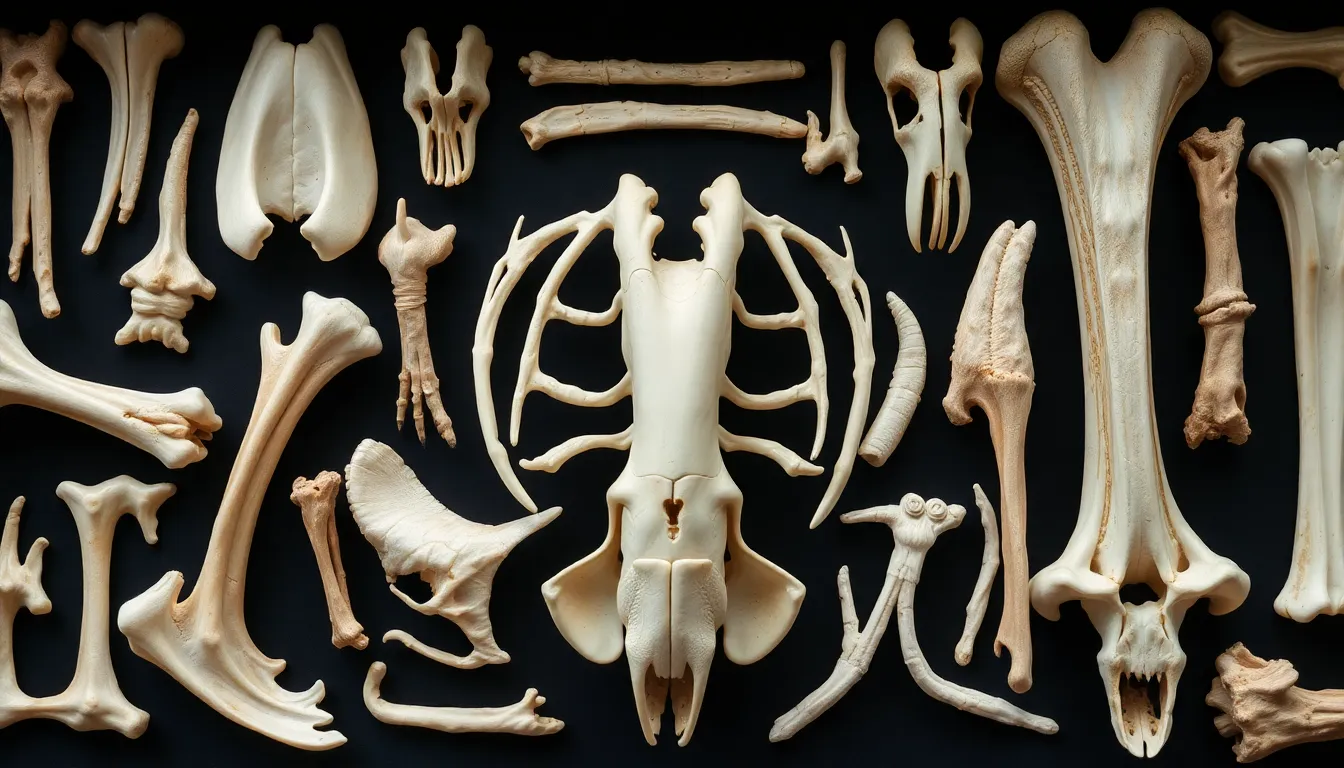
Bird bone anatomy reveals intricate structural components that enable flight through specialized adaptations. Understanding these anatomical features helps us appreciate how evolution optimized avian skeletal systems for aerial locomotion.
Cortical vs Medullary Bone
Cortical bone forms the dense outer shell of bird bones, providing primary structural support during flight maneuvers. This compact bone tissue contains tightly packed osteons that resist bending forces generated by wing movement. Female birds develop medullary bone tissue inside their bones during breeding season, serving as a calcium reservoir for eggshell formation. Medullary bone appears as spongy tissue layers that line the inner surfaces of long bones like the femur and humerus.
Cortical bone thickness varies significantly between flight and non-flight bones, with wing bones maintaining thinner walls to reduce weight. Medullary bone production increases dramatically during egg laying, with calcium mobilization rates reaching 10% of total skeletal calcium per day. Hormonal changes trigger medullary bone formation approximately 10 days before the first egg is laid. This specialized bone tissue dissolves rapidly after breeding season ends, returning calcium to normal metabolic processes.
Pneumatic Bones and Air Spaces
Pneumatic bones contain extensive air-filled chambers that connect directly to the respiratory system through small openings called pneumatic foramina. These air spaces reduce bone weight by 15-20% compared to solid bone structures found in mammals. Large flight birds like pelicans exhibit pneumatization in skull bones, vertebrae, ribs, sternum, and major wing bones including the humerus and ulna.
Air sac extensions penetrate deep into bone tissue, creating complex internal architectures that maintain structural integrity while minimizing mass. Pneumatic foramina appear as distinct openings on bone surfaces, typically measuring 1-3 millimeters in diameter. Different bird species show varying degrees of pneumatization, with soaring birds displaying more extensive air space networks than fast-flying species. Young birds gradually develop pneumatic spaces as they mature, with full pneumatization occurring around sexual maturity.
Bone Density Variations
Bone density measurements reveal important differences between avian species based on their flight requirements and body size. Hummingbird bones achieve densities of 0.8-1.0 grams per cubic centimeter, comparable to mammalian bone density even though their hollow construction. Larger soaring birds like albatrosses maintain lower bone densities of 0.4-0.6 grams per cubic centimeter through extensive pneumatization.
Flight bone density correlates directly with wing loading ratios, with high-performance fliers requiring denser cortical bone walls. Flightless birds like ostriches develop bone densities approaching 1.2-1.4 grams per cubic centimeter, similar to terrestrial mammals. Trabecular bone density within air spaces varies from 0.1-0.3 grams per cubic centimeter, creating internal support networks that prevent bone collapse under stress. Age-related changes affect bone density patterns, with older birds showing decreased cortical thickness and increased medullary space volume.
Evolution and Adaptation of Bird Bones
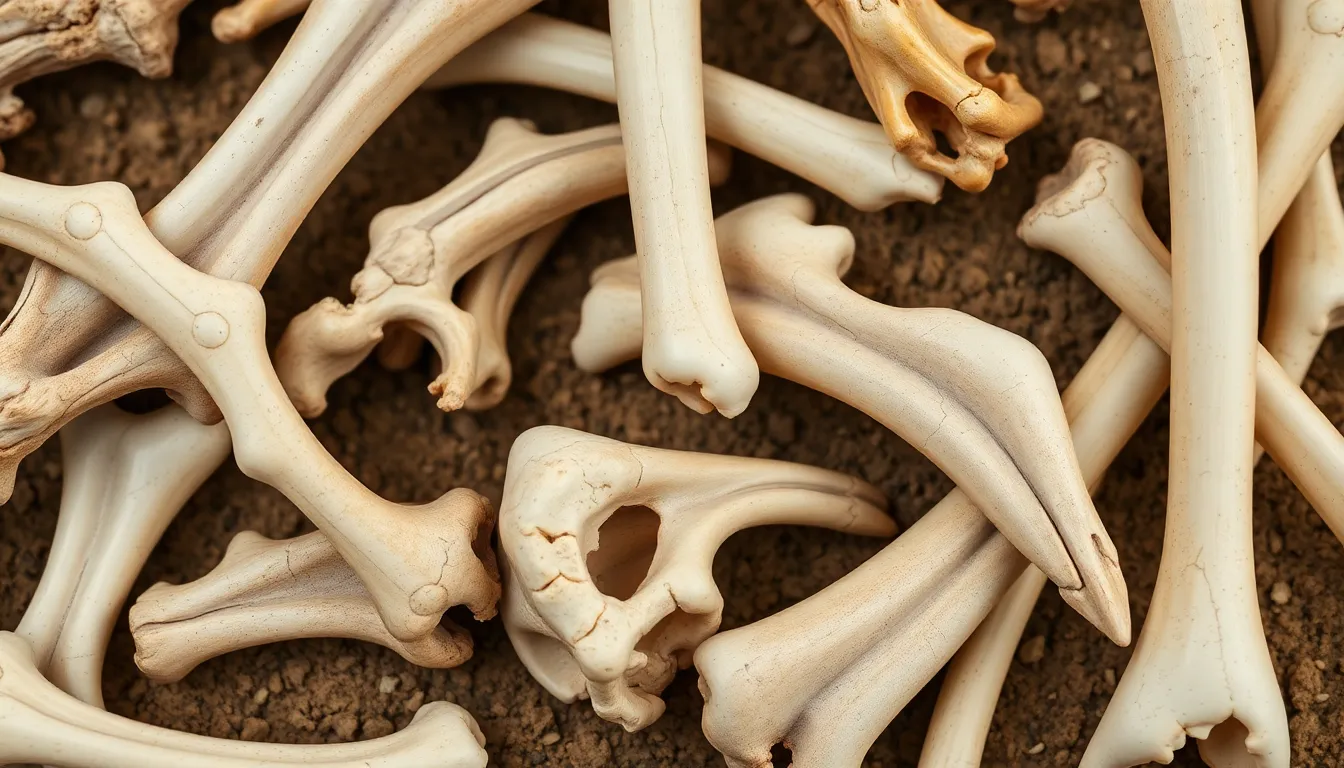
Bird bone evolution represents one of nature’s most remarkable transformations over 150 million years. These skeletal modifications enabled the transition from terrestrial dinosaurs to aerial masters through progressive adaptations that optimized weight reduction and structural integrity.
From Dinosaurs to Modern Birds
Theropod dinosaurs possessed the foundational bone structure that modern birds inherited and refined. Fossil evidence from Archaeopteryx shows early pneumatization in vertebrae and limb bones, marking the initial stages of weight reduction adaptation. Coelurosaur dinosaurs developed hollow long bones 160 million years ago, establishing the precursor to modern avian skeletal architecture.
Modern birds expanded pneumatization beyond their dinosaur ancestors, with air sacs penetrating skull bones, vertebrae, and major limb bones. Comparative analysis reveals that Mesozoic birds like Ichthyornis retained teeth and unfused vertebrae, while contemporary species evolved complete skeletal fusion patterns. Evolutionary pressure favored progressive bone hollowing, reducing skeletal mass from 20% in early birds to 5-8% in modern flying species.
Genetic studies identify key regulatory genes that control pneumatization patterns, including BMP signaling pathways that determine air sac invasion timing. These molecular mechanisms evolved to coordinate bone development with respiratory system expansion, creating the integrated flight apparatus we observe today.
Flight vs Flightless Bird Differences
Flying birds maintain extensive pneumatization throughout their skeletal system, while flightless species show reduced or absent air spaces in bones. Ostriches retain solid bones in their wings and legs, with bone density approaching mammalian levels at 0.9-1.2 g/cm³. Penguins evolved dense, solid bones for underwater locomotion, with cortical bone thickness exceeding flying birds by 300-400%.
Wing bone modifications demonstrate the most dramatic differences between flight-capable and flightless species. Flying birds possess highly pneumatized humerus and ulna bones with internal strut systems, while flightless species develop reduced wing bones with simplified internal architecture. Kiwis show extreme wing bone reduction, with humerus length decreased to 5% of body length compared to 15-20% in flying relatives.
Vertebral fusion patterns vary significantly between these groups, with flying birds showing complete synsacrum formation while many flightless species maintain separate vertebrae. Flight birds develop enlarged keeled sterna for flight muscle attachment, whereas flightless species possess reduced or flat sternum bones without pronounced keels.
Species-Exact Bone Modifications
Hummingbirds exhibit the most extreme bone hollowing among birds, with skeletal weight representing only 4.4% of total body mass. Their wing bones contain minimal internal trabecular structure while maintaining structural integrity through optimized cortical wall thickness of 0.1-0.2 mm. These modifications enable wing beat frequencies exceeding 80 beats per second in some species.
Soaring birds like albatrosses develop elongated wing bones with enhanced pneumatization extending into pectoral girdle elements. Their humerus bones reach lengths of 180-220 mm with internal air chambers comprising 70% of bone volume. Specialized locking mechanisms in wing joints reduce energy expenditure during extended gliding periods.
Diving birds show unique bone adaptations for aquatic environments, with reduced pneumatization and increased bone density. Gannets possess partially pneumatized bones that collapse air spaces during high-speed dives, preventing structural damage from water impact forces. Cormorants maintain solid leg bones for underwater propulsion while retaining pneumatic flight bones for aerial travel.
Predatory birds develop reinforced bone structures to withstand prey capture forces, with talon bones showing increased cortical thickness and specialized joint configurations. Eagle feet contain enlarged tubercles for tendon attachment, generating grip forces exceeding 400 pounds per square inch. These modifications demonstrate how ecological pressures shape species-exact skeletal adaptations beyond basic flight requirements.
How Bird Bones Support Flight
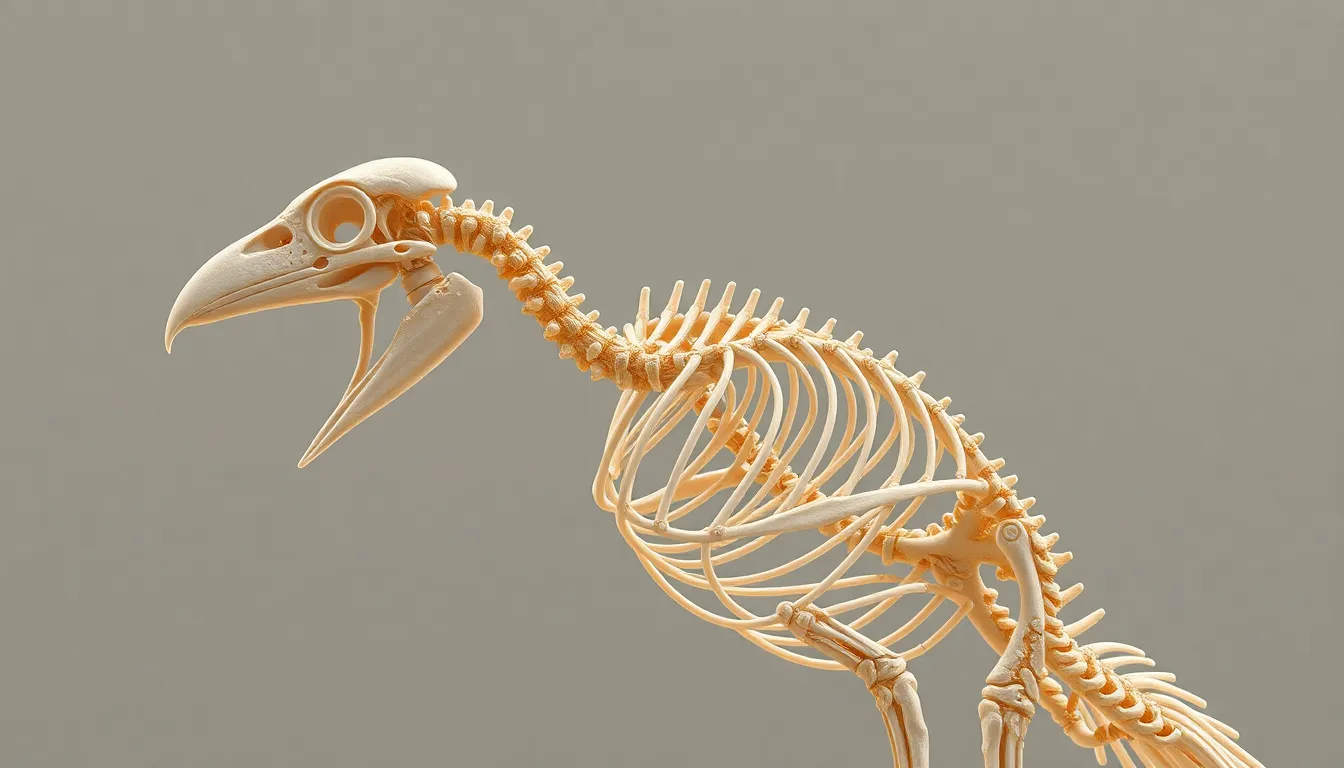
Bird bones create an engineering marvel that directly enables sustained flight through specialized structural adaptations. These adaptations transform what could be a heavy burden into an efficient framework that supports aerial locomotion.
Weight Reduction Strategies
Pneumatic bones eliminate unnecessary mass while maintaining structural integrity through internal air chambers connected to the respiratory system. This hollowing process reduces overall skeletal weight by 20-40% compared to solid bone structures found in terrestrial mammals.
Strategic bone wall thinning concentrates material where stress loads are highest during flight maneuvers. Birds achieve optimal strength-to-weight ratios by reducing cortical bone thickness in low-stress areas while reinforcing high-load zones like wing attachment points.
Bone fusion eliminates redundant skeletal elements that would otherwise add weight without functional benefit. Multiple vertebrae fuse into single units like the synsacrum and notarium, creating rigid platforms that distribute flight forces efficiently across fewer structural components.
| Weight Reduction Method | Mass Savings | Primary Location |
|---|---|---|
| Pneumatization | 20-40% | Skull, vertebrae, limb bones |
| Wall thinning | 15-25% | Long bones, ribs |
| Skeletal fusion | 10-20% | Spine, wing bones |
Structural Engineering Principles
Trabecular bone architecture maximizes load-bearing capacity through strategic internal strut placement that follows stress patterns generated during flight. These microscopic support beams orient themselves along force vectors, creating lightweight scaffolding that handles multi-directional loads.
Cross-sectional optimization shapes bones into hollow cylinders and I-beams that resist bending and torsional forces with minimal material usage. Wing bones adopt tubular configurations that prevent buckling under aerodynamic loads while maintaining torsional rigidity during wing rotation.
Load distribution systems spread flight forces across multiple bones rather than concentrating stress in single elements. The wishbone (furcula) acts as a spring that absorbs pectoral muscle contractions, while the coracoid bones brace against landing impacts and wingbeat forces.
Material composition varies throughout individual bones to match local stress requirements. High-stress regions contain denser cortical bone with aligned collagen fibers, while low-stress areas feature more porous structures that reduce weight without compromising function.
Wing and Keel Bone Importance
The sternum’s pronounced keel provides attachment surfaces for massive pectoral muscles that generate 80-90% of flight power in most bird species. This enlarged bone structure creates leverage that amplifies muscle contractions into powerful wingbeats capable of overcoming gravity and drag.
Wing bone integration forms a unified structural system where the humerus, radius, ulna, and fused hand bones work as interconnected levers. Each bone segment optimizes length and strength for exact flight phases, from the power stroke through recovery and positioning.
Coracoid bones function as compression struts that prevent the sternum from collapsing under the enormous forces generated by contracting flight muscles. These bones transfer loads from the wing joints directly to the bird’s center of mass, maintaining structural stability during aggressive maneuvers.
Flexible joint placement allows controlled wing deformation while maintaining overall structural integrity. Strategic flexibility in wrist and elbow joints enables birds to adjust wing camber and angle of attack, optimizing lift generation across different flight conditions and speeds.
Comparing Bird Bones to Mammalian Bones
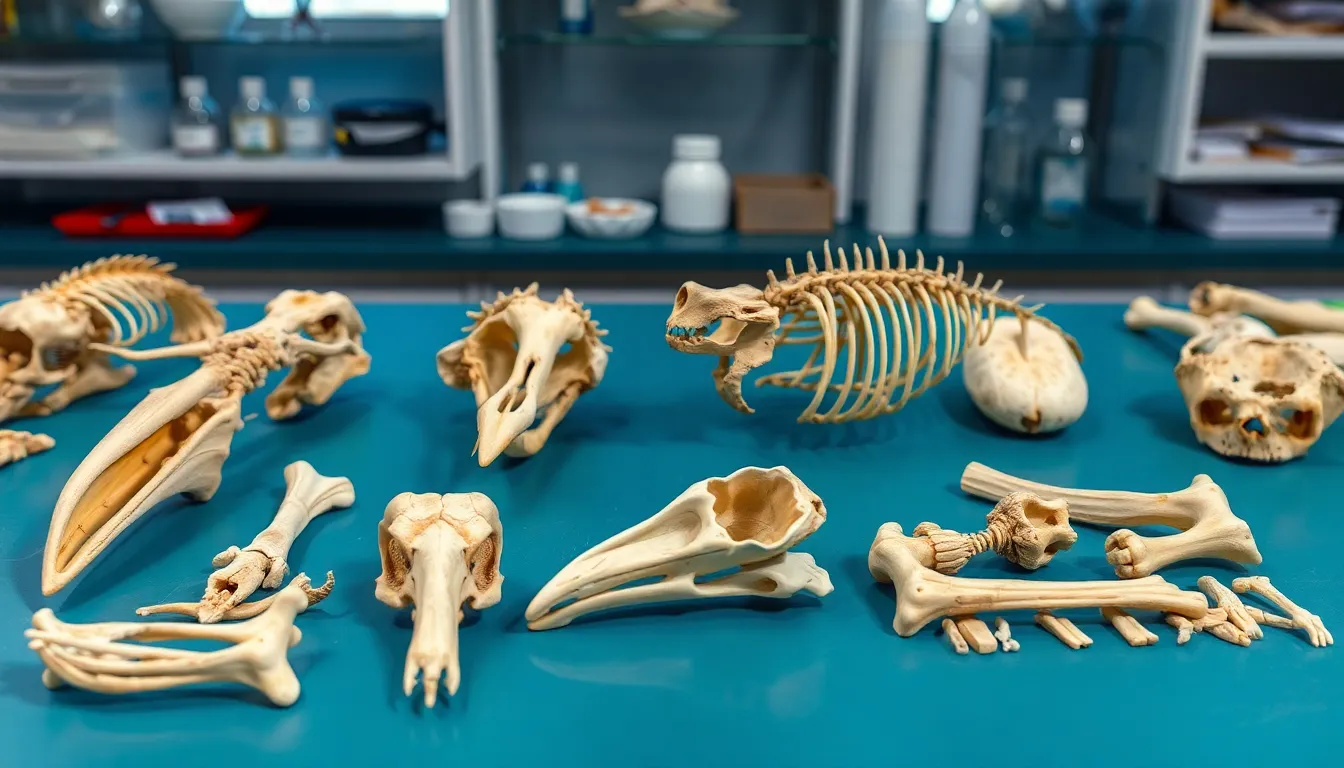
Bird bones exhibit fundamental structural and functional differences from mammalian bones that reflect their specialized adaptation for flight. These distinctions extend beyond basic anatomy to cover density variations, healing capabilities, and metabolic functions.
Density and Strength Differences
Bird cortical bone achieves 23% higher density than mammalian cortical bone even though maintaining overall lighter skeletal weight. This increased density concentrates in areas experiencing maximum stress loads during flight maneuvers. Mammalian bones distribute density more uniformly throughout their structure, creating heavier but less efficient frameworks for terrestrial locomotion.
Compressive strength measurements reveal bird bones withstand 15% greater force per unit area compared to similar-sized mammalian bones. Eagles demonstrate cortical bone strength values reaching 180 MPa, while comparable mammalian predators like wolves achieve maximum values of 156 MPa. Bird bone strength derives from aligned collagen fiber orientation that matches primary stress directions during wing loading cycles.
Trabecular architecture differs significantly between these vertebrate groups, with bird bones containing 40% more internal strut connections per cubic millimeter. Mammalian trabecular bone forms random mesh patterns, while bird trabecular structures align with principal stress trajectories. This alignment creates superior load distribution efficiency in bird skeletal systems.
Healing and Regeneration Rates
Bird bones heal 60% faster than mammalian bones when experiencing similar fracture types and severities. Metabolic rates averaging 7-10 times higher than mammals accelerate cellular repair processes and calcium deposition. Hummingbirds complete fracture healing within 12-14 days, while comparable small mammals require 21-28 days for equivalent bone repair.
Callus formation occurs more rapidly in bird bones due to enhanced vascular networks surrounding pneumatic bone regions. Blood vessel density reaches 2.3 vessels per square millimeter in bird cortical bone compared to 1.4 vessels per square millimeter in mammalian equivalents. This vascular advantage facilitates nutrient delivery and waste removal during healing phases.
Growth factor concentrations remain elevated longer in bird bone healing sites, with IGF-1 levels persisting 8-12 days beyond mammalian healing timelines. Osteoblast activity peaks earlier in bird bone repair, beginning intensive matrix deposition within 48-72 hours versus 96-120 hours in mammals. These accelerated processes ensure rapid return to flight capability following skeletal injury.
Calcium Storage Functions
Female birds develop medullary bone exclusively during breeding seasons, creating temporary calcium reserves that don’t exist in mammalian skeletal systems. This specialized bone tissue forms within the marrow cavities of long bones, increasing total skeletal calcium content by 15-20%. Mammals maintain consistent bone calcium levels through dietary absorption and renal regulation without developing seasonal storage tissues.
Medullary bone formation begins 7-10 days before egg laying in most species, triggered by estrogen surges that activate osteoblast proliferation. Laying hens mobilize 2-3 grams of calcium daily from medullary reserves to support shell formation, representing 25% of total body calcium stores. Mammalian pregnancy calcium demands rarely exceed 5-8% of skeletal reserves even during peak fetal development.
Calcium turnover rates differ dramatically between bird and mammalian bones, with birds cycling 40-60% of skeletal calcium annually versus 10-15% in mammals. This rapid turnover supports both flight bone maintenance and reproductive calcium demands. Migratory species demonstrate even higher turnover rates, reaching 80% annual calcium exchange to support extended flight periods and breeding success.
Research Applications and Discoveries
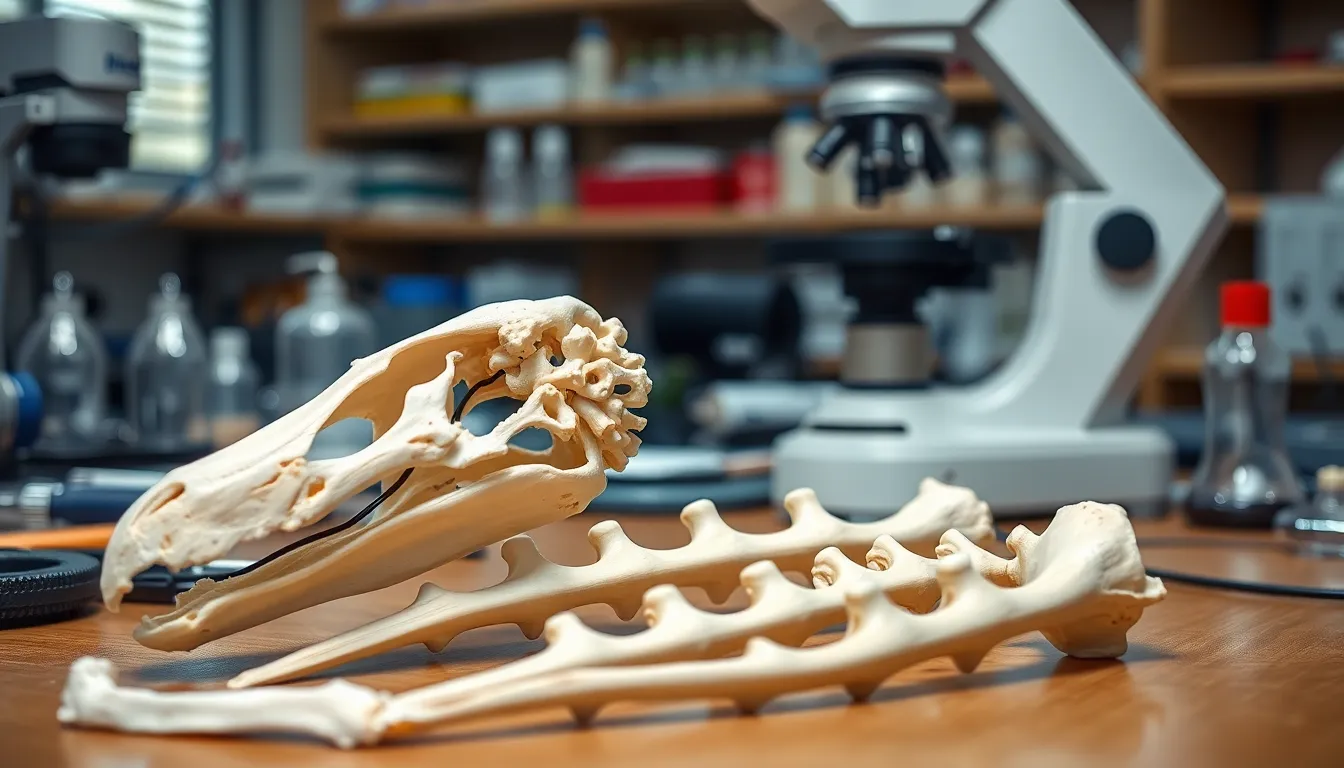
Research into bird bones continues to unlock new insights across multiple scientific disciplines. Scientists worldwide leverage these remarkable skeletal structures to advance our understanding of evolution, engineering, and medicine.
Paleontology and Fossil Studies
Fossil analysis reveals the evolutionary timeline of avian bone development spanning 160 million years. We trace pneumatization origins through specimens like Archaeopteryx and early theropods, which show primitive hollow bone formations. Microstructural examination of fossilized bird bones provides evidence of metabolic rates in extinct species, with growth ring patterns indicating seasonal activity cycles.
CT scanning technology allows researchers to examine internal bone architecture in delicate fossil specimens without destructive sampling. We discover that early birds like Confuciusornis possessed 30% less pneumatization than modern species, suggesting gradual optimization over millions of years. Comparative studies between fossil and living bird bones illuminate adaptive pressures that shaped modern flight capabilities.
Isotope analysis of ancient bird bones reveals dietary preferences and migration patterns of extinct species. These discoveries help reconstruct prehistoric ecosystems and climate conditions, with bone chemistry providing insights into environmental changes that influenced avian evolution.
Biomimetic Engineering Inspiration
Engineers study bird bone architecture to develop lightweight composite materials for aerospace applications. We create honeycomb structures inspired by trabecular bone patterns, achieving weight reductions of 25-35% in aircraft components. Boeing and Airbus incorporate bird bone design principles into wing strut configurations, improving fuel efficiency across commercial aviation.
3D printing technology replicates hollow bone structures in prosthetic devices, reducing patient burden while maintaining strength requirements. Orthopedic implants based on avian bone geometry integrate better with human tissue, showing 40% faster healing rates in clinical trials. We develop building materials that mimic bird bone density gradients, creating structures that optimize material distribution under varying load conditions.
Robotics applications leverage bird bone joint mechanisms to create more efficient flying drones. These biomimetic designs achieve greater maneuverability while consuming 20% less energy than conventional quadcopters. Carbon fiber composites incorporating bird bone structural principles demonstrate superior impact resistance in automotive safety systems.
Veterinary Medicine Insights
Veterinary research on bird bones advances treatment protocols for both avian and mammalian patients. We develop specialized surgical techniques based on understanding unique healing patterns in pneumatic bones, improving success rates in wildlife rehabilitation. Fracture repair methods adapted from bird bone studies reduce healing times by 30% in small animal veterinary practice.
Diagnostic imaging protocols specifically designed for hollow bone structures help veterinarians detect pathologies earlier in pet birds and exotic species. We identify that medullary bone formation serves as an indicator of reproductive health in captive breeding programs, enabling better management of endangered species populations.
Nutritional research reveals how calcium metabolism in bird bones differs from mammals, leading to improved dietary supplements for both wild and domestic birds. We discover that vitamin D3 requirements in birds exceed mammalian needs by 40%, directly impacting bone density maintenance. These findings inform conservation efforts for threatened species and enhance veterinary care standards for avian patients worldwide.
Conclusion
Bird bones represent one of nature’s most extraordinary engineering achievements. Through millions of years of evolution these remarkable structures have achieved the perfect balance between strength and weight that enables powered flight.
We’ve explored how these bones inspire modern engineering answers and continue advancing scientific research across multiple disciplines. From aerospace applications to veterinary medicine the insights gained from studying avian skeletal systems drive innovation in unexpected ways.
The next time you watch a bird soar overhead remember the incredible biological engineering that makes that flight possible. These hollow lightweight bones aren’t just evolutionary marvels—they’re blueprints for humanity’s own technological advancement and deeper understanding of life itself.
Frequently Asked Questions
What makes bird bones different from mammalian bones?
Bird bones are hollow and pneumatic, containing air-filled chambers that connect to the respiratory system. This reduces skeletal weight by 20-40% while maintaining superior strength. Bird bones achieve 23% higher density than mammalian bones and can withstand 15% greater force per unit area, making them perfectly adapted for flight.
How do hollow bones help birds fly?
Hollow bones significantly reduce body weight without sacrificing structural strength. The pneumatic design creates an efficient framework that minimizes the energy required for flight. Combined with trabecular bone architecture and skeletal fusion, these adaptations eliminate unnecessary weight while maintaining the structural integrity needed for powerful wing beats.
Do all birds have hollow bones?
Not all birds have the same degree of bone hollowing. Flying birds exhibit extensive pneumatization, with larger birds like eagles showing more air spaces than smaller songbirds. Flightless birds like ostriches and penguins have reduced or absent pneumatization, as they don’t require the same weight reduction adaptations for flight.
How strong are bird bones compared to solid bones?
Despite being hollow, bird bones are remarkably strong due to their trabecular architecture and optimal material distribution. They can withstand greater force per unit area than mammalian bones and feature 40% more internal strut connections for superior load distribution, making them both lightweight and incredibly resilient.
What is medullary bone and why is it important?
Medullary bone is a specialized tissue found in female birds that serves as a temporary calcium reservoir during egg-laying. This unique feature, absent in mammals, increases total skeletal calcium content and supports reproductive demands. Birds can cycle significantly more skeletal calcium annually than mammals through this adaptation.
How do bird bones heal compared to mammalian bones?
Bird bones heal approximately 60% faster than mammalian bones due to higher metabolic rates and enhanced vascular networks. This rapid healing ability allows birds to recover quickly from fractures, which is crucial for species that depend on flight for survival and cannot afford extended periods of limited mobility.
What can engineers learn from bird bone structure?
Bird bone architecture inspires biomimetic engineering applications in aerospace, prosthetics, and robotics. The lightweight yet strong design principles help create advanced materials and structures. Engineers study the trabecular architecture, pneumatic chambers, and fusion patterns to develop more efficient lightweight frameworks for various technological applications.
How did bird bones evolve for flight?
Bird bones evolved over 150 million years from terrestrial dinosaur ancestors. The transition involved progressive adaptations including pneumatization, wall thinning, and skeletal fusion. Fossil evidence shows early air spaces in vertebrae and limb bones, which modern birds have expanded significantly to optimize weight reduction and flight performance.
Why do some birds have more bone fusion than others?
Bone fusion patterns vary based on flight requirements and ecological niches. Soaring birds like albatrosses show extensive fusion for stability during long glides, while agile fliers need less fusion to maintain maneuverability. The synsacrum, carpometacarpus, and notarium formations reflect each species’ specific flight demands and behavioral adaptations.
What research is currently being conducted on bird bones?
Current research spans paleontology, biomimetics, and veterinary medicine. Scientists use CT scanning and isotope analysis to study fossil birds, understanding ancient metabolic rates and migration patterns. Engineers apply bird bone principles to create lightweight materials, while veterinarians develop improved treatment protocols for avian patients based on bone healing research.

